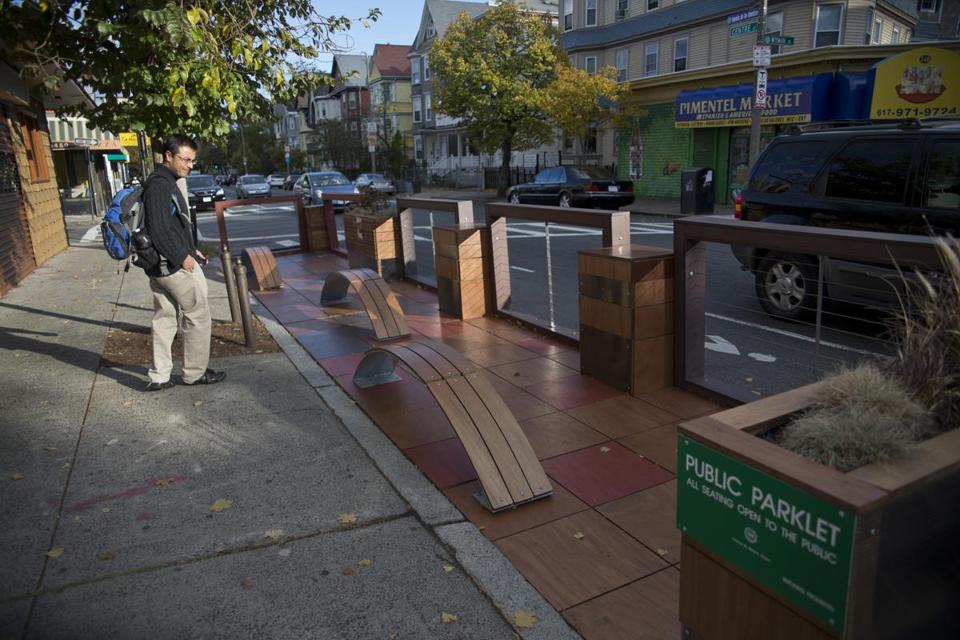The parklets were supposed to be a social hub, a nexus of activity, a tiny urban oasis where locals could gather to chat, read, sip coffee, tap away on their laptops, or simply enjoy being part of a metropolitan streetscape.
Instead, Boston’s two parklets — on-street parking spots that the city converted into mini-parks by adding benches and plants — landed with a thud.
Since the city installed a parklet in Jamaica Plain at 351 Centre St. and another at 1528 Tremont St. in Mission Hill in early September, at the cost of between $15,000 to $25,000 each, observations from abutters, passersby, and Globe reporters suggest that they are hardly the happening spots in town.
.
So how come? Was it the design?
Some nearby residents said they believe potential parklet-goers were deterred by the uncomfortable benches — the parklet in Jamaica Plain features curved, half-moon shaped seating — the parklets’ proximity to street traffic, or confusion about whether they were allowed to use them.
Circumstance?
Vineet Gupta, the Transportation Department’s planning director, cited a handful of reasons that the parklets haven’t been as popular as hoped. For one, Tacos el Charro, a restaurant near the Jamaica Plain parklet, closed unexpectedly. Without a bustling business in close proximity, Gupta said, there was less of a reason for people to linger.
The source?
Transportation experts say the lackluster performance of the two parklets speaks to the challenges of innovation by city agencies. When public space projects aren’t a home run, they’re quickly maligned — and public scorn makes transportation officials wary of experimenting with new ideas in the future.
Are parklets something that has to come from the community?
Brendan Crain, spokesman for the Project for Public Spaces, a New York-based nonprofit that promotes use of urban spaces to build community, said the mark of a good public space project is not whether it is immediately successful, but whether the project coordinators listen to residents on the best way to fix it.
Or is just a matter of time?
“This is true for parklets, it’s true for bike lanes, it’s true for bus lanes — it’s true for any innovation in the transportation world,” Gupta said. “Initially, you don’t see the kind of use that one would hope, but things pick up.”














It’s the benches.
There’s no backrest and 2 people can’t comfortably sit next to each other.
Also, try eating your lunch while balancing on a curved surface.
They may function better as exercise benches if you add some resistance bands.
I agree the benches are unappealing. The bike lane provides some separation from motor vehicles, but it’s an awkward location because of the side street on the left. The barricade across the far end sends a subconscious message to pedestrians that this is a private space that they’re not free to enter. Had the end been wide open to the crosswalk it would have looked like a space pedestrians are supposed to visit, but I’m sure safety concerns mandated the barricade.
To see a successful conversion from roadway to appealing pedestrian space, albeit on a larger scale, visit Bute Street between Barclay and Haro.
It’s just so common nowadays…
The people who design our cities have no idea how to design cities for people.
Lets see… Transport/Traffic Engineers ensure that traffic flows nicely … Civil Engineers ensure that traffic moves safely… Star Architects ensure that the place looks nice…
Who ensures that a place is actually used by people?
The best people for this job are sociologists or psychologists, because they actually understand what makes street life happen. Like Jane Jacobs!
If you want to see a local example of this failure, I challenge you to go to the Roundhouse Turntable. I multimillion dollar project that nobody uses (except on hollidays).
But luckily, projects initialized by store owners contain a bit more common sense. They actually see WHY people would want to use the parklets (because they own their store in front of it). Like one on commercial drive! http://www.kickstarter.com/projects/julienfthomas/commercial-drive-parklet
What an excellent blog, sir. Thank you.
I love visiting Vancouver (I live in the Other Vancouver, but visit Birch Bay regularly). It’s clearly the sanest, most intelligent and consistently aesthetic city in North America.
Well done, Canadians!
“Guest” got it right. Only one person can sit on one of these benches, at its peak, without sliding off. That means this design joke can only be used by three people, who would be sitting about as far from each other as possible. So much for conversation. Nothing to lean against, either, unless you’re standing. I don’t see the fence at the end as a problem– parklets commonly provide a comforting sense of enclosure– and many of those I’ve seen at intersections work well.
It’s a classic lesson in bad design, which the city staff should have caught. Who was the architect?
Disagree. I don’t think we should blame the benches. The second quote states that a restaurant closed recently. That is the main culprit.
I’m looking at Google Street View right now: (http://goo.gl/maps/nNx7L), and it’s clear that even with a restaurant, a lack of street life is evident considering that the area is low density and car oriented. (Any thing less than mid-rise is low density). There simply isn’t any people. It’s like an empty park bench in winter. There is little reason for people to spend time in a parklet when they can sit at home. If you build a single parklet on a street where few people walk by, let alone stay and stand, the parklet will not cause a significant increase in pedestrians to appear.
Reblogged this on archiabyssniya.
These are nice bandaids ideas by city councilors with no vision, no imagination and o guts.
Just widen the sidewalks, or better, close the road altogether.
Street in Vancouver are far too car centric. Every second street in Vancouver, starting with downtown, then going to denser communities like Kits, E-Van or Kerrisdale need to be closed for cars and be green streets.
Where is the vision in Vancouver by our “green” mayor ?
cars should not go over 30 km/h, and as such most roads in Vancouver could be narrower.
Onstreet parking needs to be reduced by 50% and parking, especially in residential neighborhoods needs to be increased by 400-1000% to $400 to $3000/year.
Thomas is spot on. His idea is excellent. We need to implement something similar to Groningen where cars must go *around* and not *through* the city centre. But I think Thomas’s plan is a bit too ambitious and would never win political support.
A more viable alternative would be completely closing off Granvile Street downtown to through traffic AND not allowing any cars to cross granville street. This means to get from chinatown to coal harbour by car would involve looping to pacific boulevard under granville bridge.
Or, a simpler step forward would be to close water street to cars: http://257vancouver.wordpress.com/2013/09/25/pedestrianize-water-street/